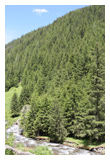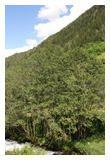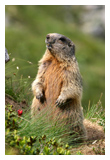| |
Vegetation, flora and fauna
 The vegetation extends from the meadows at the bottom of the valley and its swamp regions up to the alpine pastures in the higher regions. The predominating forest formation is coniferous forest, consisting of spruces and some fir trees. Amongst the deciduous trees you will find alder and willow besides the riverbanks while mountain ash, ash, maple and beech trees enrich the biological variety of the coniferous forests. On the way to the higher regions thin larch groves give way to the alder, then the alder is substituted by rhododendron bushes and finally alpine meadows. The landscape in the higher regions is enriched by enchanting, hardly known lakes, like the Lago di Torsolazzo, di Torsoleto, di Sonno and di Picol. The vegetation extends from the meadows at the bottom of the valley and its swamp regions up to the alpine pastures in the higher regions. The predominating forest formation is coniferous forest, consisting of spruces and some fir trees. Amongst the deciduous trees you will find alder and willow besides the riverbanks while mountain ash, ash, maple and beech trees enrich the biological variety of the coniferous forests. On the way to the higher regions thin larch groves give way to the alder, then the alder is substituted by rhododendron bushes and finally alpine meadows. The landscape in the higher regions is enriched by enchanting, hardly known lakes, like the Lago di Torsolazzo, di Torsoleto, di Sonno and di Picol.
The flora of the nature reserve is one typical of acid soil; the swamp areas and the peat bogs, the lakes and the carbon permit the growth of seldom and endemic species like Aquilegia alpina, Isoetes echinospora, Drosera rotundifolia, Ranunculus trichophyllus and the rare orchids Listera cordata and Corallorhiza trifida.
The reserve shelters innumerable species of fish, reptiles, birds, insects and typical mammals of the alpine fauna. Amongst them one can find several species in danger of extinction and indicator species, only found in regions hardly affected by the human influence.
 The wildlife stock is in excellent conditions because of the presence of the society “Faunistico-Venatoria Belviso-Barbellino”, which for many years has set special scientific criteria. The society runs a total surface of 11000 hectares comprising parts of the provinces of Brescia, Bergamo and Sondrio and including the area of common importance and the nature reserve of St. Antonio. The hunting, permitted only to members of the society, is subjected to strict regulations. Only a specific number of animals can be shot, the number depends on the actual population which is constantly monitored and counted by the technical direction of the society and a team of rangers and biologists. They also take care of the zoological and sanitary interests of the wildlife stock. Inside the area of the nature reserve hunting is forbidden. The wildlife stock is in excellent conditions because of the presence of the society “Faunistico-Venatoria Belviso-Barbellino”, which for many years has set special scientific criteria. The society runs a total surface of 11000 hectares comprising parts of the provinces of Brescia, Bergamo and Sondrio and including the area of common importance and the nature reserve of St. Antonio. The hunting, permitted only to members of the society, is subjected to strict regulations. Only a specific number of animals can be shot, the number depends on the actual population which is constantly monitored and counted by the technical direction of the society and a team of rangers and biologists. They also take care of the zoological and sanitary interests of the wildlife stock. Inside the area of the nature reserve hunting is forbidden.
Amongst the mammals you can find alpine goat, moufflons, deer, marmots, ermines, squirrels, snow hares and hares, badgers, hedgehogs, stone martens and martens. The fox is easy to locate, especially during the wintertime, when it is strolling around, looking for food. Easy to recognize are its unmistakable traces in the snow. Amongst the big birds of prey are the eagle, the buzzard, the Common Kestrel and the Merlin. During the night the long-eared owl, Eurasian eagle owl, screech-owl and brown owl are hunting for prey. Rock partridge, partridge, hazel grouse, heath-cock and, only recently discovered, the rare mountain-cock, are to be found in the well conserved forests, in the  pasture areas of the higher regions, in the larch groves and in the steep rocks of the less accessible regions. pasture areas of the higher regions, in the larch groves and in the steep rocks of the less accessible regions.
One can also discover reptiles and amphibians, the reptiles prefer the sunny and rocky slopes hardly affected by the human presence and always near the lakes, the amphibians are to be found in the peat bogs or in the neighbourhood of standing water. The most widely spread amphibian is the grass frog (Rana temporaria). Interesting is the occurence of different species of bats and insects. Some of the insects, like the southern wood ant, are crucial to the sanitary soundness of the forest.
|
|
